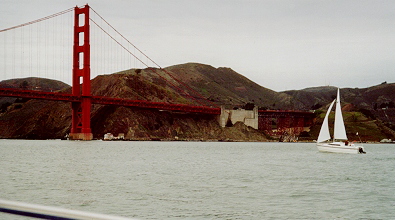I’m occasionally asked if I miss the larger, deep draft sailboat. The answer is always no. That type of craft now seems to me like a helpless one-legged seabird soaring above the surface of the sea, never able to safely land or seek shelter.
Ron Hoddinott
Small Craft Advisor
March/April 2006 issue, pg 26


Blue Water Sailing views high comfort ratios (50 or above) representative of “sluggish” vessels, where the duration of the uncomfort is possibly extended, and low comfort ratios (20 or below) representative of “jerky motion” vessels, where while the duration of the uncomfort is shorter its intensity may be viewed as high.
So for ocean use the motion comfort ratio range of 20 to 50 appears representative of true ocean cruisers by Blue Water Sailing magazine standards. Murrelet, when loaded for most ocean endeavors, is in that range.
Displacement on a Mac26x ocean cruiser will include not only water ballast but also allowance for 85 lbs per person per week of food and fresh water (rule of thumb) as well as personal gear and safety gear/ extra fuel for ocean passage and anchor tackle. The weight of the crew is also part of the displacement. While the total displacement changes while cruising it is unlikely that “jerky motion” is going to be a valid description of Mac26x ocean behavior. Brewer recognizes that sails when up reduce uncomfortable motion and water-ballasted boats take rough conditions with significantly more comfort for their crews. Since I am reluctant to call any boat that can capsize and then sink ocean worthy, I am inclined to consider most monohulled sail boats (MacGregors, Poters, and Etaps being the exceptions) as deficient for ocean crossing work. Manufacturers of sail boats that can sink need to rethink their classification schemes which are misleading. Should any sail boat without solid flotation really be classified as “open ocean capable of withstanding hurricane”?

In 2002 Murrelet embarked on a circumnavigation of Vancouver Island, where I hoped to observe first hand Mac26x ocean behavior. The crew was distracted by warm weather and whale and bear watching and hence the only ocean swells dealt with were those blown into the Strait of Juan De Fuca and Haro Strait.
Our experience showed our cruiser to be sturdy and duck like in waves that are large enough for the propeller to be lifted out of the sea. What this means is that Murrelet bobbed over large waves rather than slicing through them like my sister’s Catalina 42.
A technique for surfing the waves was developed. At conclusion of a rough Haro Strait passage, we noted that our cruiser had reached 17MPH during the motor-only fully-ballasted lots-of-surfing crossing. I was able to compare our experience with that of a distressed 34 foot sailboat captain whoes crew abandoned him once reaching port owing to sea anxiety. A mini transat (smaller than a Mac26x) completed the Van Isl 360 race in 2005 and several Mac26x cruisers have circumnavigated the island so this work is well within the capabilities of the vessel.



[youtube http://www.youtube.com/watch?v=GwTxA7n67H4?feature=player_detailpage&w=640&h=360%5D
[youtube http://www.youtube.com/watch?v=xFVtqJH04i0?feature=player_detailpage&w=640&h=360%5D
[youtube http://www.youtube.com/watch?v=g4JELoPdD7Y?feature=player_detailpage&w=640&h=360%5D
[youtube http://www.youtube.com/watch?v=g4JELoPdD7Y?feature=player_detailpage&w=640&h=360%5D